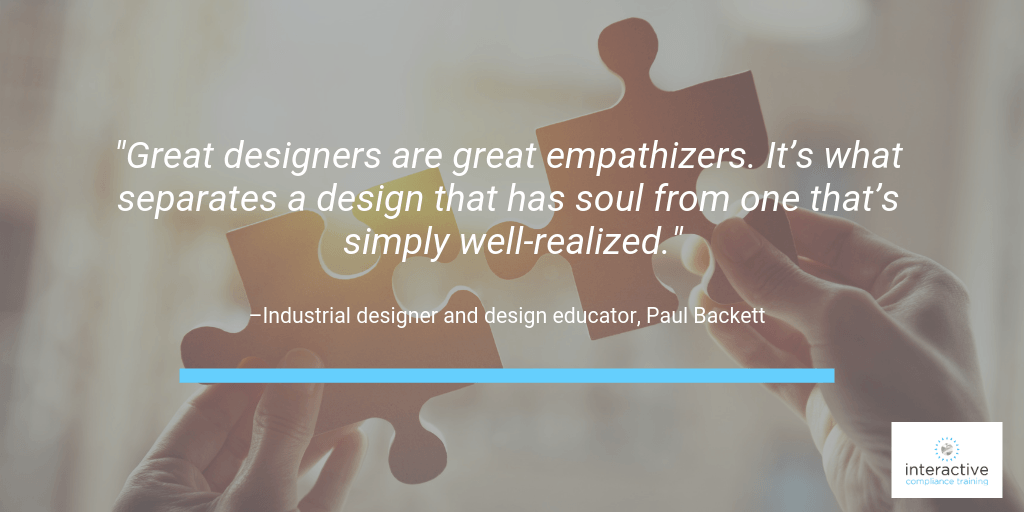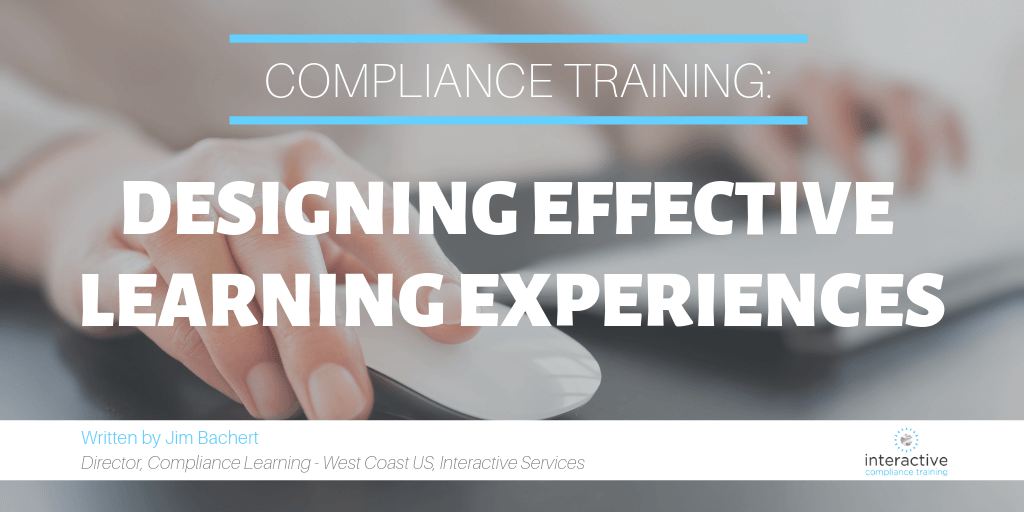
“Great designers are great empathizers. It’s what separates a design that has soul from one that’s simply well-realized.”
– Industrial designer and design educator, Paul Backett
The modern era of training and e-learning is often characterized by the learning coma – a phenomenon in which learners are lulled into a semi-conscious state of boredom and ennui, all the while trying to care, but in reality, suffering from a serious motivation gap. To prevent the learning coma and to offer adults truly transformative learning experiences, designers must rethink the way they design and develop learning.
Designing effective learning experiences is both an art and a science that incorporates a number of strategies, including:
- Empathizing with learners’ challenges
- Designing sound and profound learning experiences
- Incorporating adult learning principles
- Engaging learners’ emotions
- Developing a mind-blowing learning experience
- Providing ongoing feedback

Empathizing with Learners’ Challenges
To walk a mile in your learners’ shoes, get a feel for their frustrations, issues, and challenges by:
- Conducting Interviews:Interview managers, supervisors, and employees to clearly understand the challenges they face and the opportunities available to them.
- Leading Focus Groups:Conduct group research to explore and understand the attitudes and challenges of employees. Aim to discover their values and beliefs. Become familiar with what motivates and demotivates them. Understand the tools they use and the processes they must follow.
Designing Sound and Profound Learning Experiences
A keen insight into what your learners are looking for forms the basis of any training or e-learning course you design and develop. Once armed with an understanding of your learners’ needs, you can then set out to design sound and profound learning experiences. Remember too that the aim of any effective learning experience is rooted in acquiring the skills, knowledge, motivation, and confidence to change existing behaviors or create new ones. Those changes in behavior should have measurable impacts, allowing you to define key success metrics.
As a learning experience designer, focus your time and attention on identifying the gaps that exist between learners and their desired outcomes. Those gaps typically exist due to a lack of the following:
- Knowledge: Do learners lack the proper information to complete a task?
- Skills: Do they possess the right information but lack the ability to apply that knowledge?
- Confidence: Can they apply the skills, but do they hesitate to do so?
- Motivation: Can they apply the skills confidently but are unmotivated to do so?
- Tools/Resources: Do they lack the proper tools or resources to complete a task?
Once you identify the gaps your learners are grappling with, design a solution that effectively addresses those gaps.
- What do you want your learners to do?
- What must learners know in order to do this?
- What tools or resources must they have in order to do it?
Before you create any training, craft solid learning objectives – a list of specific performance-related goals the learners should be able to reach after the training is completed. These are your guiding principles. Once this step is complete, create content that helps learners achieve those objectives. The quizzes, assessments, case studies, and hands-on exercises performed during training should align with your objectives.
Remembering Adult Learning Principles
Keep in mind that you’re designing for adult learners who:
- Learn best when they understand what’s in it for them. This is essential for motivation. Otherwise their buy-in will be minimal and your learning outcomes will fall flat.
- Are self-directed. This means that learners can control what they learn and, to a degree, how they learn.
- Come to training with wisdom. Tap into learners’ lifetime accumulation of knowledge, experience, and skills.
- Are goal-oriented. Ideally the learning experience should enable adult learners to achieve goals that will improve their job performance.
- Want relevant training. Don’t waste adult learners’ time on training that’s not relevant to their job performance. Respect them by designing a learning experience that is only as long as it needs to be in order to meet their objectives and yours.
Engaging Learners’ Emotions
Once you’ve completed your design – or the course blueprint – it’s time to start developing your unique learning experience. Make the first five to ten minutes of your course truly inspiring, and you will engage learners from the outset. If you fail to grab their attention within the first ten minutes, you’re likely to lose your audience.
The “hook” appeals to learners’ emotions, pulls them in, and motivates them to fully engage. Research has shown that emotionally evocative events imprint in our memory for longer than events that are neutral. Emotional cues activate neurons in the brain and remind learners of things associated with that emotion.
Developing a Mind-blowing Learning Experience
Then, where appropriate, introduce a relevant and interesting story. A learning experience can be designed as a story with a narrative arc. Related concepts should be introduced in a way that make sense and achieve the learning objectives. Training designers should think about the overall learning experience as a carefully crafted series of learning sequences.
Create a series of scenarios that relate to real-life examples learners are likely to encounter. Customer experience scenarios are a perfect example. If you’ve written a lesson about showing empathy in a difficult customer service scenario, present a story in which the learner must choose how to respond in a given situation.
Consider a strategy in which the content is presented, demonstrated, practiced, and evaluated. You should try to include as much hands-on practice or simulation as possible. The first segment is presented by the instructor or the online course. Learners are given the information related to a concept and then provided with examples that bring the content to life. In the second segment, the learner performs an action to model the examples they were shown, while getting feedback from the instructor, fellow learners, or online course. Then, the learner can apply what they’ve learned in a real-world (or simulated) environment. Whenever possible, put the learners in charge of the learning process, not the instructor.
Varying the Means of Delivery
If you’re developing instructor-led training, consider varying the means of delivery to include content generation, reflection, teach-backs, games, contests, and social learning. For online courses, use audio, video, interactive games and scenarios, blogging and social media forums. And for blended learning, use a combination of the above recommendations.
Providing Ongoing Feedback
Provide immediate feedback when learners make choices as they advance through their learning experience. Offer rationale as to why an answer is correct or incorrect. Feedback should be presented at just the right time for maximum impact. In a branching scenario, a learner might not select the perfect answer but may choose one that is acceptable.
When you’re designing learning experiences for modern learners, infuse your design with heart and soul by empathizing with learners, designing sound and profound learning experiences, incorporating adult learning principles, appealing to learners’ emotions, mixing up the delivery methods, developing transformative learning experiences, and offering continuous feedback. Learning experience designers must change the way learning in the modern era is viewed by surprising and delighting learners, giving them what they need, but also by engaging their hearts and minds for a learning experience that stays with them long enough to make a difference in their jobs, and maybe even in their lives.



